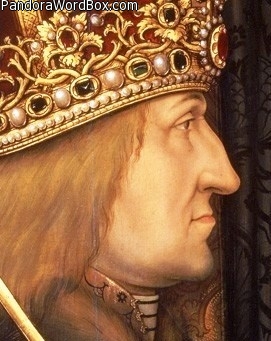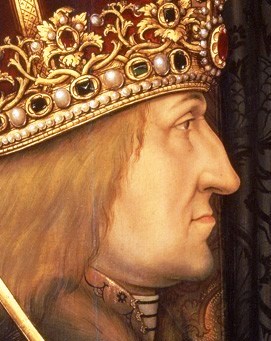Our websites offer information mostly for educational purposes with no intent to alter health care protocols nor to serve as a sole source of medical information.
Always seek the advice of your local health care provider.
|
× UKRAINIAN CHILDREN WITH DISABILITIES HAVE SPECIAL NEEDS |
ww

(details from "Federick III and his spouse (see related images) ") (see related A | B | C | D), 1468 Hans Burgkmair (1473-1531) Kunsthistorisches Museum, Vienna, Vienna, Austria
A companion related image shows more clearly the signs of the "Habsburg" autosomal dominant mutation manifested as mandibular prognathism evident here in Frederich III (see full image).
Note a mystery discussed in companion entries - in brief, Frederich had a son Maximilian who had a son known as "Felipe el Hermoso". Felipe with Joan "the mad" had a son who became Carlos I (among Spaniards) or Charles V (among German speakers) - the mystery arises from the fact that Carlos I or Charles V had the same prognathism and other dysmorphisms evident as his grand-father and other relatives, while his parents did not - how come? - how did this mutation reappear in Carlos, which he passed on to his son Felipe, etc. - how did this mutation reached Carlos? - was Juana raped or having an affair with another "Habsburger" with the mutation? - a new mutation? - unlikely - new mutations are very rare in contrast to seduction/rape, etc. Note that Juana was known for her beauty! - Felipe and later her son Carlos have her "jailed" and declared "insane" - such does not hide the fact of the bizarre inheritance by Carlos of a mutation evident in his grandfather, great-grand-father, and other relatives ... a nice script for a dramatic film.
Signs: "Habsburg" prognathia and nose (more evident in companion images).
Signal: in combination with a family history of same signs evident in approximately one half of male or female descendants of those affected is strongly indicative of an autosomal dominant gene phenotype.
20210413 ww
|









